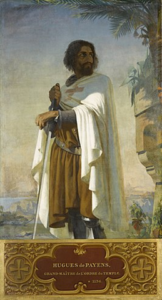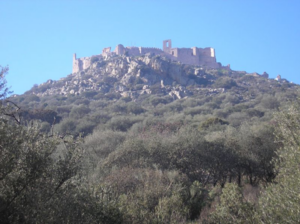In the first part, we delved into the history behind the Assassins. In this new part, we will explore the history of the Templars.
If you haven’t read the first part yet, click here to read it. The Templars, also known as the Knights Templar (Order of the Poor Knights of Christ and the Temple of Solomon), were a Christian military order during the Crusades. This order waged war against the Muslims during the Crusades. They were organized as a monastic order modeled after the Cistercian Order, which was both monastic and militarily active.
To better understand the Templars, we will also take a closer look at the Cistercian Order. The Cistercians trace their origins back to 1098 when Abbot Robert, a Burgundian nobleman, left his monastery in Molesmes to establish a new monastery in Citeaux, Burgundy, with twelve other monks. The new order was a response to the declining adherence to the Rule of Benedict.
Rule of Benedict
The Rule of Benedict, known in Latin as *Regula Benedicti*, consists of a prologue and 73 chapters. Chapters 1-3 lay out the foundations of life in the monastery. In chapters 4-7, Benedict discusses the rules and requirements a monk must follow, and religious figures vow loyalty to the monastery. Chapters 8-20 cover the *opus Dei* and the work of God. Chapters 21-30 discuss the penalties for breaking these rules. Chapters 31-57 cover general and practical matters such as the maintenance of the monastery, the duties of the monks, and how the monks should treat their guests. Chapters 58-66 discuss the admission and position of Novices, the hierarchy within the monastic community, the duties of the abbot and prior, and the role of the porter. In chapters 67-72, Benedict discusses the interactions among the monks, and the final chapter is an epilogue.
Now that we have discussed the *Regula Benedicti*, let’s delve further into the background of the Templars. The order originated from a brotherhood of mainly French crusaders, of whom at least one was Hugues de Payens.
Hugues de Payens
Hugues de Payens was the first Grand Master of the Templar Order and served alongside Godfrey of Bouillon, the Duke of Lower Lorraine and one of the leaders of the First Crusade. He was also proclaimed the first King of the Kingdom of Jerusalem, although he declined this title, preferring instead the title of “Advocate” or “Defender of the Holy Sepulchre.” He is also known as the Baron of the Holy Sepulchre and King of the Crusaders. Godfrey’s parents were Count Eustace II of Boulogne and Ida of Verdun, and he was also a descendant of Charlemagne.
Not much is known about Hugues de Payens; he was likely born at Château Payns, 10 km from Troyes in the province of Champagne. According to William of Tyre, Hugues de Payens founded the order in 1118 with eight others. However, some documents suggest that the order was founded earlier, in 1114. This remains unclear. According to these documents, the founding group consisted of not eight but nine knights, although little is known about this as well. André de Montbard, born in 1103 in Jerusalem, was the fifth Grand Master and the ninth Templar. André was likely from Burgundy and was probably an uncle of the spiritual leader Bernard of Clairvaux.

The order existed for at least 200 years. The brotherhood mainly consisted of a small group of knights primarily tasked with protecting pilgrims in Palestine. These pilgrims were often attacked by local inhabitants during their journey through the Holy Land. The order was also closely associated with the County of Champagne and was primarily established to increase the region’s influence and not necessarily to save Jerusalem from the Muslims.
Despite their vow of poverty, the Templars became a very wealthy order in the Kingdom of Jerusalem and the captured Crusader territories, including in Europe. In Europe, the order owned large estates, thanks to the support of many nobles. When a noble joined the order, they would donate all their possessions to it. Since the order was exempt from taxes, they became one of the most important and largest bankers in the West.
The well-known *cheque*, known at the time as a *bill of exchange*, is one of the Templars’ inventions. The Templars and pilgrims had contacts with the local Islamic upper class. Through these contacts, the Templars became familiar with Western Europe. The knights were thus able to help their European contemporaries adopt these cultural and scientific riches. The internationally operating order transported large sums of money to the Holy Land, developing into an international banking house.
The King of France was heavily in debt to the order. Combined with their growing power, this likely prompted Philip IV of France to persecute the order for heresy. This happened after years of political pressure, during which the king allegedly had two popes murdered to ensure that his confidant, Pope Clement V, would be elected. On Friday, October 13, 1307, the king ordered the arrest of the Templars and accused them of heresy. On November 22, 1307, the pope issued the *Pastoralis praeeminentiae*, instructing all Christian rulers in Europe to arrest all Templars and seize their movable and immovable property.

The Templar Order waged a holy war against Islam and, after the fall of Jerusalem and other key cities, became part of the occupying force in the Holy Land.
The last Grand Master of the Templars, Jacques de Molay, died at the stake on March 18, 1314. During this trial, the order was accused of many things, including homosexuality and the worship of Baphomet. Stories circulated at the time that he cursed the king and the pope, and both died within a year.
Many gameplay elements in the Assassin’s Creed series closely align with history, although Ubisoft has partially adapted the story of the Assassin’s Creed series. In the series, the factions are long engaged in a war over their beliefs and ideals. The modern Templars in the Assassin’s Creed series continue under the name Abstergo Industries, though Abstergo Industries, through their ideals, diverge significantly from the original Templars in the series. In theory, they are essentially a splinter group of the Templars. How this all fits together will be further explored in the third and possibly final part of this series.
In this part, we highlighted the history behind the Templars, compared it to our history, and drew parallels. In the third part, we will delve deeper into the battlefields, crusades, and the ongoing conflict depicted in the game series for centuries.